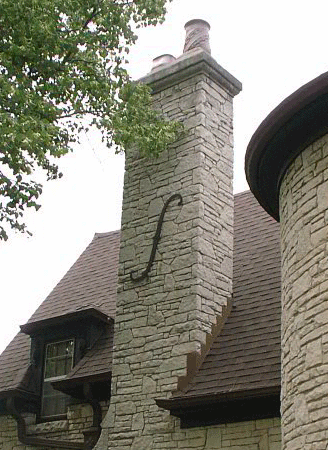chimney

A chimney is a masonry or metal stack that creates a draft to bring air to a fire and to carry the gaseous by-products of combustion safely away.
Chimneys harness the heat of the fire to create what's called a chimney effect or stack effect. As the warm air from the fire rises, cooler house air rushes into the fire, e.g., through vents in a wood-burning appliance, providing the oxygen the fire needs to burn. Starting a fire with a good hot burn will encourage this healthy draft to flow. Also, between the higher and lower pressure zones of the home lies a neutral pressure zone. The neutral pressure zone tends to move toward the largest air leak. When the top of the chimney is located above the home ceiling (as it should be), the chimney's neutral pressure zone is above the neutral pressure zone of the house. Such proper chimney placement creates a gentle flow of air into the appliance and out the chimney even when no fire burns.
If you are designing or building a new home, consider placing the chimney inside your home. A more traditional chimney, constructed along the outside of a home, will lose valuable heat to the cold, outside air. If the chimney air temperature falls below that of the inside air, the cold, smelly chimney air will be pulled into the house by the low pressure of the stack effect. In such a scenario, the house has become a better chimney than the chimney. So when a fire is lit, smoke fills the room.
Chimneys must match the size of the appliance, meaning the flue size should match the diameter of the stove outlet. If the chimney is bigger than the stove or fireplace outlet, exiting exhaust slows, increasing creosote buildup and decreasing efficiency. High-performance chimneys are also insulated. Older masonry chimneys can be relined to safely and efficiently connect them to newer high-efficiency, wood-burning appliances. Again, the chimney liner should be continuous from the appliance outlet to the chimney top. It is not uncommon to pay as much for the chimney as for your appliance.
Free-standing wood stoves exhaust into a connecting pipe, which then connects into the chimney. If the connecting pipe is longer than 8 feet (as in a vaulted ceiling), you should consider investing in double-layer pipe with 1-inch (2.5-centimeter) airspace between pipe layers. Efficient modern stoves produce large amounts of heat. Much of this heat can radiate from a longer length of single-layer pipe, slowing down the draft, which can impact the overall efficiency of your wood-burning system.
